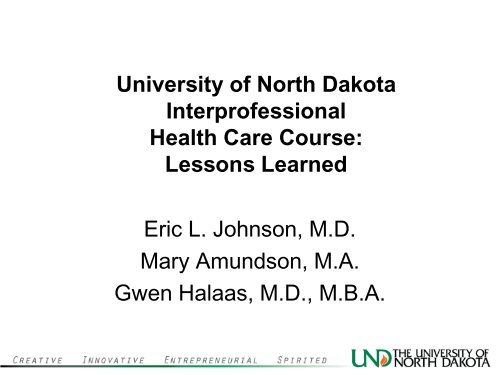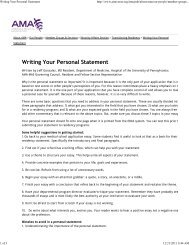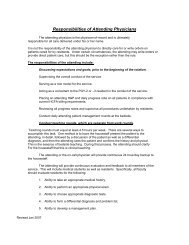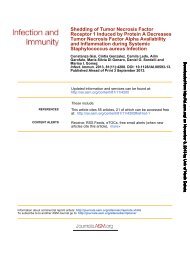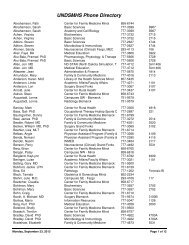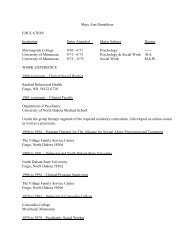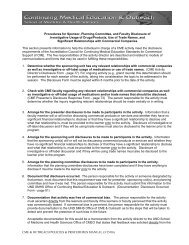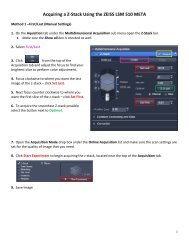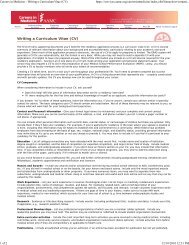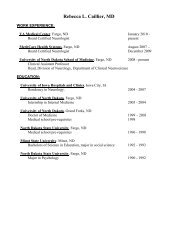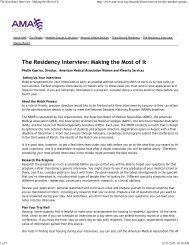What do Students Say? - School of Medicine & Health Sciences ...
What do Students Say? - School of Medicine & Health Sciences ...
What do Students Say? - School of Medicine & Health Sciences ...
Create successful ePaper yourself
Turn your PDF publications into a flip-book with our unique Google optimized e-Paper software.
University <strong>of</strong> North DakotaInterpr<strong>of</strong>essional<strong>Health</strong> Care Course:Lessons LearnedEric L. Johnson, M.D.Mary Amundson, M.A.Gwen Halaas, M.D., M.B.A.
Disclosures(Dr. Johnson)• Astra Zeneca, Bristol-Meyers SquibbSAVOR-TIMI 53 multicenter trial, GrandForks PI• Novo Nordisk, speaker’s bureau
Objectives• Demonstrate to the audience how this particularcourse was developed to enhance studenteducation in an interpr<strong>of</strong>essional group setting toimprove communication• Provide evidence that communication and theroles <strong>of</strong> the various team members areenhanced through this course• Identify needed areas to increaseinterpr<strong>of</strong>essional student interaction
Course Background• 2003 Task Force under direction <strong>of</strong> then-UNDSMHS Dean H. David Wilson, M.D.and under the direction <strong>of</strong> Mary Wakefield,Ph.D.,R.N.• The course was launched in January 2006.• Participants:– Required: OT, PT, Nursing, <strong>Medicine</strong>,Communication <strong>Sciences</strong> and Disorders,Nutrition and Dietetics– Elective: Music Therapy, Social Work
Course Objectives• Apply knowledge and perspectives <strong>of</strong> healthpr<strong>of</strong>essions in team discussions aboutpatient/client care situations.• Apply group skills in case managementapproaches.• Demonstrate patient/client-centered approach indecision-making as an interdisciplinary team.• Demonstrate ability to reflect about teamexperiences and feedback.• Identify sources <strong>of</strong> potential error andconsequences to health care delivery.
Course Structure• Modeled after a Patient-Centered Learning Curriculum at SMHS• 2 six week sessions each semester• Large group and small group sessions• Typically 70 students per 6 week session• Small group usually have at least 4 disciplines, 10 students• Meet weekly for 3 hours• Pass/fail grading system• Most groups meet at SMHS, sometimes one distance learning OTgroup in Casper, WY• 90 minute facilitator training prior to course• Faculty facilitators represented across all participating disciplines• 2152 students 2006-2012
Course Structure 2006-2012• First week: “First Night”-Large group introduction to IPE,Team STEPPS, and impact <strong>of</strong> medical errors-Small group• Weeks 2 through 6-Case studies incorporating understanding <strong>of</strong>roles, TeamSTEPPS concepts• Minor transitional changes autumn 2012(medical pictionary for first night small group)
<strong>What</strong> <strong>do</strong> <strong>Students</strong> <strong>Say</strong>?Fall 2008• Communication <strong>Sciences</strong> & Disorders(CSD): This course allowed me to see<strong>do</strong>, as well as what my role in the healthcare setting is.• <strong>Medicine</strong> (MS): I am better aware <strong>of</strong> what the others pr<strong>of</strong>essions <strong>do</strong>,what they are capable <strong>of</strong>, and their role in health care.• Nursing (NSG): This course prepared me to work in the health caresetting by letting me see the whole picture <strong>of</strong> collaborative care andhow everyone needs to work together as team members for qualitypatient care; I liked being able to listen to other health pr<strong>of</strong>essions
<strong>What</strong> <strong>do</strong> <strong>Students</strong> <strong>Say</strong>?Fall 2008• Occupational Therapy (OT): The strength <strong>of</strong> the coursewas that it allowed all <strong>of</strong> the students from otherprograms to come and learn together and interact withone another.• Physical Therapy (PT): This course has helped me tounderstand different health care pr<strong>of</strong>essions. I havelearned more about who they are and what they <strong>do</strong>. Inow feel like am better able to communicate withdifferent disciplines more effectively.• Social Work (SW): Working as a team, I learned thateveryone's input maybe be different. But the approachescan be the same with honest opinions and conflictinginterests.
2011:TeamSTEPPS(Team Strategies and Tools to Enhance Performance and Patient Safety)Introduction
<strong>What</strong> <strong>do</strong> <strong>Students</strong> <strong>Say</strong>?Spring 2011(TeamSTEPPS Introduction)• CSD:– The TeamSTEPPS is a comprehensive approachthat will help me in delivering services in thehealthcare setting. I have learned the values <strong>of</strong> theTeamSTEPPS approach and know that this will goa long way to help my pr<strong>of</strong>essional development.– The cases presented had very dicey andchallenging situations that made it necessary toknow how other pr<strong>of</strong>essionals see it. Thus I learnedto listen to people <strong>of</strong> other pr<strong>of</strong>essionals disciplinesand thereby learned a lot from them.
<strong>What</strong> <strong>do</strong> <strong>Students</strong> <strong>Say</strong>?Spring 2011(TeamSTEPPS Introduction)• PT: I think it is a great way to have consistencywithin the health care pr<strong>of</strong>ession. It also showedthat communication problems <strong>do</strong> happen andpreventing them from happening, like using theSTEPPS, will make a big difference to the patient.
<strong>What</strong> <strong>do</strong> <strong>Students</strong> <strong>Say</strong>?Spring 2011(TeamSTEPPS Introduction)• OT:– I really liked that we have the opportunity tobrainstorm and interact with students from otherpr<strong>of</strong>essions. This assisted me with being more aware<strong>of</strong> the roles <strong>of</strong> other pr<strong>of</strong>essionals as well as theappropriate way to interact with other pr<strong>of</strong>essionals.– I find this to be an excellent way to communicate withother pr<strong>of</strong>essions concerns and comments regardingthe patient. It was used well in the course materials.
<strong>What</strong> <strong>do</strong> <strong>Students</strong> <strong>Say</strong>?Spring 2011(TeamSTEPPS Introduction)• NSG:– Having an open discussion about the case so thateveryone can state their input. It showed thateveryone can bring something new to the situationand everyone involved should have a voice.– I feel that my learning experience with TeamSTEPPShas been very beneficial and it will continue to besomething that I utilize in order to effectivelycommunicate with team members within a health caresetting during my pr<strong>of</strong>essional practice.
MS:<strong>What</strong> <strong>do</strong> <strong>Students</strong> <strong>Say</strong>?Spring 2011(TeamSTEPPS Introduction)• TeamSTEPPS is a good program and while it may notbe used explicitly in our future pr<strong>of</strong>essions, theunderlying theme will un<strong>do</strong>ubtedly be utilized daily, sothe exposure to the material this early in our schooling isquite useful.• I understood what other disciplines think about medicalissues and how they approach the treatment <strong>of</strong> thepatient. I was then able to understand why theyapproach plan <strong>of</strong> care options differently than myself.
Lessons Learned –<strong>Students</strong>’ Perspective• The course should be modeled around theTeamSTEPPS program rather than just trying toincorporate aspects <strong>of</strong> TeamSTEPPS here and there.• The course <strong>do</strong>es not flow very nicely in terms <strong>of</strong> the use<strong>of</strong> TeamSTEPPS. The knowledge level is also a barrierto participation for some because they have not hadexperience with patients or healthcare.• Find a way to incorporate all pr<strong>of</strong>essions- nursing knewall <strong>of</strong> the answers and I felt like it needed to be gearedtowards the other areas
Lessons Learned –<strong>Students</strong>’ Perspective• The case studies had a lot <strong>of</strong> focus on the area<strong>of</strong> nursing. More focus in other disciplines wouldmake the case studies more valuable to thewhole group and to the discussion.• I understand that it is difficult to find a time thatworks in everybody's schedule, but eveningclasses are very hard for me to be motivatedand engaged with.
Lessons Learned – <strong>Students</strong>’Perspective• The wide range <strong>of</strong> clinical experienceamongst the group creates an unfair dynamicin terms <strong>of</strong> overall input towards the clinicalissues raised with each patient. With all <strong>of</strong> themembers being at distinctly different times intheir training, it is quite apparent that some<strong>do</strong> not have or <strong>do</strong> have specific clinicalexperiences from which they can pull from.
IPHC Course “Overall Satisfaction”(by Program 2006-2011)(1 = Strongly Dissatisfied; 5 = Strongly Satisfied)
IPHC Course “Overall Satisfaction”(by Program 2006-2011)
Trend in Student Satisfaction with IPHCFacilitator (Overall Satisfaction)1 = Strongly Dissatisfied; 5 = Strongly Satisfied(Number <strong>of</strong> facilitators per term is shown beneath the mean rating.)
Course Changes - 2013• Continued Large Group/Small Group format-TeamSTEPPS retainedas introductory piece• First night added a medical pictionary game for small groupintro/orientation• Week 2: Error Disclosure Module (University <strong>of</strong> Washington) added– Medical Team must disclose a preventable medical error to a“family member” role play activity• Weeks 3 through 5: ALS case study/<strong>do</strong>cumentary(“So Much, So Fast”), blog• Week 6: Create/present an education, communication, advocacy,ethics piece on ALS• Overall orientation toward teamwork, less on “clinical knowledge”• 30 minute “just in time” facilitator training
Future Directions• Expand/Add cases• Integrate low tech/high tech simulation• Add other disciplines-Psychology-Physician Assistant-<strong>Health</strong> sciences from other institutions(i.e., PharmD)• Theatre students added for fall 2013 for “familymember” role play
Acknowledgements• UND IPHC Team:• Maridee Shogren, MSN,, CNM, College <strong>of</strong> Nursing, IPHC Co-Team Leader• Charles E. Christianson, M.D., Associate Dean <strong>of</strong> Clinical Education <strong>Medicine</strong>• Stephanie J. Christian, MS, RN, Clinical Associate Pr<strong>of</strong>essor <strong>of</strong> Nursing• Thomas Hill, PhD, Director, Office <strong>of</strong> Medical Education• Gwen Halaas, MD, MBA, SMHS Senior Associate Dean Academic & Faculty Affairs• Anne Haskins, PhD, OTR/L Assistant Pr<strong>of</strong>essor, Occupational Therapy• Roger Johnson, MSW, Assistant Pr<strong>of</strong>essor, Social Work• Joann Johnson, AAS, IPHC Interim Course Coordinator, SMHS• Andrew Knight, MA, MT-BC, NMT Fellow, Music Therapy• Mark Romanick, PhD, PT, ATC, Associate Pr<strong>of</strong>essor <strong>of</strong> Physical Therapy• Mary Jo Schill, MA, CCC-SLP, Clinical Assistant Pr<strong>of</strong>essor, Communication <strong>Sciences</strong> andDisorders• Desiree Tande, PhD, Assistant Pr<strong>of</strong>essor, Nutrition and Dietetics• Eric Johnson, MD, Assistant Pr<strong>of</strong>essor, Department <strong>of</strong> Family and Community <strong>Medicine</strong>, IPHCCo-Team Leader
Questions/Comments


